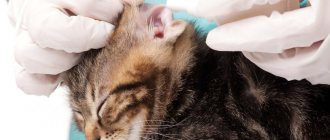What is piroplasmosis
Let's immediately decide on one nuance. Despite the prevailing opinion among some experts that piroplasmosis does not occur in cats, most of the veterinary community adheres to the exact opposite. This disease occurs in cats, and is not so rare . In the meantime, we need to decide what kind of disease this is.
Piroplasmosis is a blood-parasitic disease, which is contracted through the bites of blood-sucking parasitic ixodid ticks. Since cats walk through forests and fields less often than dogs, they “catch” these parasites much less often.
Perhaps this is precisely why the opinion about the rarity or even the impossibility of piroplasmosis in these animals is connected.
Prevention measures
To prevent your pet from becoming infected with piroplasmosis, it is necessary, first of all, to protect it from attacks by ixodid ticks. Therefore, for a walk, it is better to choose places where the likelihood of these blood-sucking insects appearing is extremely low, for example, a sunny meadow blown by the wind. It is better to walk with the animal at noon, when the bloodsuckers are hiding and not hunting. You should also avoid narrow paths with tall grass or bushes growing on the sides. This is where ticks are usually found, waiting for a victim.
To bite, insects usually choose areas where the skin is thinnest—the inner thighs and abdomen. If a tick has attached itself to the neck under the lower jaw, the vigilant owner will immediately notice this, since the pet will begin to scratch the bitten area.
But the correct choice of place for a walk and subsequent inspection of the animal to detect a tick, unfortunately, will not prevent infection if the insect ends up on the pet’s body. Therefore, the most effective preventative measure is to treat the cat’s skin and fur with acaricides, which neutralize the insect, causing paralysis of its limbs.
Chemical treatment against ticks is carried out during the warm period - from May to September. Drugs containing permethrin prescribed in such cases for dogs and mustachioed pets are not suitable - such drugs are too toxic for them.
Sprays or drops containing fipronil are used to treat furry pets. An adult cat is treated 24 hours before a planned walk in the park/forest. The product is applied to the withers area so that the pet cannot lick it off. The active substance accumulates in the sebaceous glands under the skin without entering the blood. The effect lasts for a month.
Piroplasmosis in cats, the symptoms of which appear 1.5-2 weeks after infection, is a rather dangerous disease. If you do not seek help from a veterinarian in time, the animal may die. Since Babesia enters the body of a pet through the bite of an ixodid tick, measures should be taken in advance, that is, before the onset of the warm season, to protect the animal from these blood-sucking insects.
Do cats get piroplasmosis?
And now it’s time to answer the same interesting question: “Do cats get piroplasmosis?” And we repeat once again - yes, they do get sick, although heated debates on this topic are still ongoing among some experts.
But it should still be noted that doubts about the “plausibility” of feline piroplasmosis did not appear out of nowhere. There are still no plausible studies in this area... But it is reliably known that piroplasmosis occurs very often in wild cats. Most reports of feline piroplasmosis come from fairly warm countries where, in principle, there are no particularly cold winters.
From this we can draw an interesting conclusion: it is quite possible that cats are parasitized by a slightly different type of piroplasm. It is likely that initially it was found only in the south of Europe (by the way, it was there that the causative agent of piroplasmosis was first described), but due to globalization and a general softening of the climate, Babesia begins to migrate. In any case, by default, cat owners are better off assuming that their pets are also susceptible to tick bites.
Causes and route of infection
An acute course of the disease can take the life of your pet in just a few days.
Therefore, every loving owner should know where piroplasmosis comes from in cats. So, the cause is a mite. More precisely, not the blood-sucking insect itself, but the smallest intracellular parasites - Babesia, which it infects at the moment of saturation. However, research has shown that there is a specification of Babesia, which is called Felis, that is, feline. Fortunately, piroplasmosis in cats most often occurs with virtually no symptoms. Therefore, even experienced breeders note that in their entire lives they have never encountered the need to treat their pet.
Piroplasma or Babesia affects hundreds of species of mammals, but birds suffer from this parasite quite rarely. The bacterium was first discovered by Victor Babes, a Romanian bacteriologist who identified the cause of diseases in cattle in 1887.
In the 20th century, scientists identified six varieties of these microorganisms. Cats are affected by Babesia felis, a parasite that is three times smaller than the causative agent of the disease in dogs. Animals that have Babesia in their bodies become carriers of a dangerous disease.
Piroplasmosis can affect absolutely any cat, regardless of breed and age. Most often, young animals under three years of age are affected. An outbreak of the disease is usually observed during the period of greatest activity of ticks, that is, in the warm season (spring-summer).
Before entering the cat's body, Babesia live in the body of the ixodid tick - an intermediate host, which is only a carrier of the infection. For the insect itself, piroplasms are harmless. They colonize the tick's intestinal lining, where they form spores.
Having attached itself to a healthy cat and drunk on its blood, the insect begins to regurgitate the contents of the stomach, and thus Babesia enters the body of the mustachioed pet. Once in the animal’s bloodstream, the parasite migrates, penetrating red blood cells and feeding on their contents—hemoglobin.
Incubation period
The length of the incubation period may vary. If a small amount of bacteria has entered the animal's bloodstream, and the cat is young and healthy, the first symptoms may not appear until several weeks later. In case of severe infection with the penetration of a large number of bacteria into the weakened body of the pet, babesiosis manifests itself after 2-3 days.
On average, the incubation period lasts 10−14 days. Feline piroplasmosis belongs to a group of fairly rare diseases; moreover, it often does not manifest itself in any way, so even a specialist cannot always immediately determine the cause of a pet’s illness. Meanwhile, precious time is lost, and lack of treatment leads to the death of the cat.
Although this pathology in cats is quite rare, every pet owner needs to be aware of the symptoms of the disease. The following signs should raise suspicion:
- The cat’s behavior changes - it becomes lethargic, inactive, and constantly lies huddled in a dark corner.
- The animal completely or partially loses its appetite. Some cats refuse to eat from the very first days, which causes them to suddenly lose weight.
- Severe shortness of breath is often observed. The animal's breathing becomes shallow and frequent.
- Fever appears. Body temperature rises to 41 degrees, sometimes higher.
- Even with a sluggish course of the disease, the cat quickly loses weight and becomes exhausted.
Since piroplasmosis causes the destruction of erythrocytes (red blood cells), the animal develops hemoglobinuria, that is, blood appears in the urine. Jaundice is more typical for the chronic form of the disease. Most often, all visible mucous membranes are susceptible to icterus (jaundice); in severe cases, the skin may also turn yellow. The fur becomes coarser and stiff.
But the most serious consequence of the active proliferation of bacteria is the massive destruction of red blood cells. Cases of chronic piroplasmosis are characterized by the appearance of nuclear forms of red blood cells: the body begins to release their immature forms into the bloodstream, thus trying to compensate for the deficiency of red cells.
Lack of treatment leads to more severe symptoms. The clinical picture looks like this: in a sick pet, the heart rate (heart rate) slows down significantly, the pulse becomes rare. The cat is breathing slowly and heavily. In addition, there are disruptions in the functioning of the gastrointestinal tract: diarrhea, vomiting and nausea occur, or, conversely, constipation that occurs due to innervation.
If the cat is not helped, it may die or become a carrier of the disease, which is also dangerous both for other pets and for itself - every time with the slightest decrease in immunity, the pathology again takes on an acute form.
If the infection occurs at an advanced age, the pet will most likely die, since its body will no longer be able to cope with the disease. In severe cases, the death of the animal occurs already on the second day, since piroplasmosis is characterized by lightning-fast development.
Piroplasmosis is a seasonal or “dacha” disease. It usually starts in April and ends in October. The indicated gap is not accidental: the carrier of the disease is the ixodid tick infected with piroplasma. When an animal is bitten by a tick, intracellular Babesia parasites enter the latter's bloodstream.
In animals with piroplasmosis, the level of red blood cells is 2-3 times lower than in healthy animals.
To date, it has been precisely established that cats suffer from piroplasmosis infrequently: over the past 20 years, about 10 cases have been recorded in Russia. At the same time, it has been scientifically proven that cats are attacked by the parasite Babesia felis. They are several times smaller than Babesia canis, an intracellular parasite that commonly causes piroplasmosis in dogs.
Can infection occur from a sick animal? Veterinarians do not rule out this possibility if there are wounds on the skin of the cat in contact with him. Infection through blood transfusion is also likely.
All pets enjoy walks in nature. Unfortunately, this is not always safe. With the onset of warm days, ticks, which are carriers of dangerous diseases, are released into the wild. Such ailments include piroplasmosis. Many veterinarians still believe that this disease is dangerous only for dogs, but recent clinical studies have refuted this theory.
We suggest you read: What to feed your Yorkshire Terrier
Symptoms and first signs of piroplasmosis
Any breeder needs to know the symptoms and first signs of feline piroplasmosis (however, they are not much different from the canine variety):
- The animal becomes unusually lethargic, refuses active games and tries to spend as much time as possible lying down in some dark corner.
- Accordingly, the cat’s appetite sharply worsens or completely disappears. Some pets completely refuse to eat from the very first days of illness, which leads to catastrophically sharp weight loss.
- In many cases, shortness of breath develops and the cat's breathing becomes fast and shallow.
- Fever is characterized by a constant or intermittent type, when the body temperature can rise to 41° Celsius (or higher).
- Even in the case of a sluggish course of the disease, the development of progressive exhaustion is characteristic. In this case, the cat may become like a “bag of bones.”
Since piroplasma affects red blood cells (erythrocytes), resulting in the destruction of the latter, hemoglobinuria may develop (in other words, blood appears in the urine).
For cases of chronic piroplasmosis, jaundice is more typical. Jaundice (icterus) primarily manifests itself on all visible mucous membranes; in severe and advanced cases, even the skin may turn yellow.
At the same time, the pet's fur becomes hard and rough. But still, the most serious consequence of the rapid proliferation of piroplasms in the blood is the destruction of an increasing number of red blood cells. In chronic cases, it even comes to the appearance of their nuclear forms: the body, trying to cope with the lack of red blood cells, begins to release their immature, “premature” forms into the general bloodstream.
What happens after a bite?
Ixoid mites are intermediate hosts for parasitic protozoa of the piroplasma family. In the tick's body, piroplasms undergo part of their development cycle.
The causative agent of piroplasmosis enters the animal’s bloodstream, when bitten, with the tick’s saliva, and begins to multiply intensively in the red blood cells.
Red blood cells die en masse, releasing hemoglobin. Hemoglobin is partially removed in the urine, turning it red, and is partially converted into bilirubin, resulting in yellowness of the mucous membranes and eyes.
The number of red blood cells in animals with piroplasmosis is reduced by 2-3 times compared to the normal level. As a result, severe anemia develops - anemia, which entails, as a compensatory reaction, increased breathing and pulse, and increased heart contractions. Excessive stress on the heart muscle leads to cardiac hypertrophy.
Toxic products accumulate in the blood and tissues, metabolism is disrupted, and inflammatory and degenerative processes occur in the spleen, liver and kidneys. Acute kidney failure develops.
Diagnostics
Babesiosis is not diagnosed based on clinical signs. The reason lies in the fact that the clinical picture of this disease is quite vague and not very characteristic. The only way to detect the disease in cats is a microscopic examination of the blood.
In this case, an experienced specialist focuses not only on the detection of piroplasms themselves, but also on the characteristic changes in blood cells. In addition, in recent years, PCR has been increasingly used for this purpose (but the technique is not used so often - it is expensive and requires specific equipment).
Establishing diagnosis
Since the symptoms of babesiosis can indicate many different diseases, its diagnosis begins in the standard way - with a clinical examination and a survey of the owners. Clinical and biochemical blood tests are immediately prescribed.
If blood parasitic diseases are suspected, and this occurs if a clinical blood test reveals a decrease in red blood cells and hemoglobin, a test for hemoparasites is prescribed. It can be performed in two ways: blood smear microscopy and PCR.
Feline babesiosis must be distinguished from hemobartonellosis. Both diseases cause increasing anemia, but are treated differently. The optimal diagnostic methods also differ: hemobartonellosis is a relatively common disease, and PCR methods exist and are widespread for it. Babesiosis in cats and dogs is caused by at least 5 different types of blood parasites: 1 for cats and 4 for dogs. For canine Babesias, the method is again common; both Babesiacanis and Babesiagibsoni, Babesiamicroti and Babesiaconradae can be determined. If the laboratory can determine PCR for Babesiasp., that is, all known types of piroplasms, such an analysis is suitable for a cat.
Microscopy is a less accurate analysis; it is not always possible to detect parasites, especially since different types of parasites look different, and Russian laboratory doctors, due to the exotic nature of feline piroplasms, have difficulty visually diagnosing them.
Therefore, for cats with suspected babesiosis and a negative test for hemobartonellosis in the southern regions, it is advisable to carry out PCR for piroplasmosis.
Treatment of piroplasmosis in cats
Let us immediately note that the treatment of piroplasmosis in cats is a rather lengthy and difficult procedure. The problem is that the drugs used for this are highly aggressive towards the liver and excretory system of the animal.
We would not recommend treating this disease at home. Since the animal requires constant supervision of a veterinary specialist, it is more advisable to use the hospital option.
Help at home
The very first aid at home should be to immediately contact a veterinarian. You still can’t do anything significant on your own.










